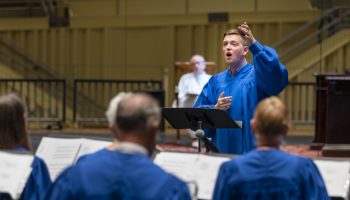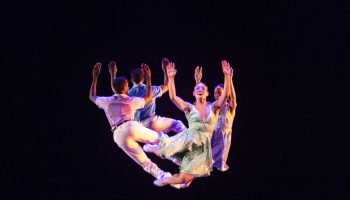España, Rhapsody for Orchestra
Emmanuel Chabrier
French composer (Alexis) Emmanuel Chabrier was born in Ambert, Puy-de-Dôme, Jan. 18, 1841, and died in Paris on Sept. 13, 1894. His most famous work is the orchestral rhapsody España. According to the second edition of the New Grove Dictionary of Music and Musicians, Chabrier’s most significant output were songs, piano pieces and stage works. Despite the small number of works he composed, they are considered to be of high quality and proved influential on French composers in the first quarter of the 20th century. España was originally composed for piano and was later transcribed for orchestra by the composer. It was premiered on Nov. 4, 1883, and was dedicated to the conductor Charles Lamoureux, who conducted the first public performance at the Théâtre du Château d’Eau for Paris’s Société des Nouveaux Concerts. The work is scored for piccolo, two flutes, two oboes, two clarinets, four bassoons, four horns, two trumpets, two cornets, three trombones, tuba, timpani, percussion, two harps and strings.
The allure of Spain proved too strong for composers from other countries to resist. Maurice Ravel, although French, was half Basque, and his Boléro, Alborada del gracioso and Rapsodie Espagnole are ample evidence of his affinity for Spanish musical idioms. Chabrier was another Frenchman who fell in love with Spain, its culture and its music, largely as a result of the time he spent there in 1882. He wrote to a friend in November of that year:
“In a month I must leave adorable Spain and say good-bye to the Spaniards — because (I say this only to you) they are very nice, the little girls. … Every evening we go to the café-concerts where the malagueñas, the Soledas, the Zapateados and the Peteneras are sung. Then the dances, absolutely Arab, to speak truth. If you could see them wiggle, unjoint the hips, contort, I believe you would not try to get away!”
España makes use of two song/dances — the malagueña and jota. Opulently orchestrated, the soul of the guitar and castanets is never far away.
Suite from “The Three-Cornered Hat”
Manuel de Falla
Manuel de Falla (y Matheu) was born Nov. 23, 1876, in Cádiz, Spain, and died Nov. 14, 1946, in Alta Gracia, Argentina. “The Three-Cornered Hat” began as a two-act pantomime with the title The Corregidor and the Miller’s Wife. It was composed 1916 to 1917 and received its first performance in this form April 7, 1917, in Madrid under the baton of Joaquín Turina. In 1918-1919, the composer expanded the work into a two-act ballet, now retitled “The Three-Cornered Hat.” This version was first performed by Diaghilev’s famous Ballets Russes on July 22, 1919, in London under the direction of Ernest Ansermet. The choreography was created by Léonide Massine and the scenic design and costumes were made by Pablo Picasso. It is scored for two flutes (two piccolos), two oboes, English horn, two clarinets, two bassoons, four horns, three trumpets, three trombones, tuba, timpani, percussion (snare drum, bass drum, cymbals, triangle, castanets, tam-tam, xylophone), harp, celesta, piano and strings.
Falla emerged in the first half of the 20th century to become one of Spain’s most prominent composers. Fully immersed in his native culture, the composer moved to Paris in 1907, where he mingled with the likes of Claude Debussy, Maurice Ravel, Paul Dukas, Igor Stravinsky and his fellow countryman Issac Albéniz. He remained there until the outbreak of World War I.
Upon his return to Spain, Falla consolidated his preeminence among Spanish composers, as well as establishing his international reputation with works such as “El amor brujo” (Love the Magician), La vida breve, Noches en los jardines de España (Nights in the Gardens of Spain) and the work at hand. He composed very little after 1926, at which time he moved to Mallorca. In 1939, he moved to Argentina, where he remained the rest of his life.
Pedro Antonio de Alarcón y Ariza’s novel, The Three-Cornered Hat (El sombrero de tres picos), gave rise to at least two significant musical compositions, one being Hugo Wolf’s opera, Der Corregidor, first performed in 1896. Another was the pantomime written by Spain’s foremost composer of the first half of the 20th century, Manuel de Falla, under the title The Corregidor and the Miller’s Wife (El corregidor y la molinera). In Spanish culture, a corregidor is a magistrate (literally, “corrector”) — an administrative figure with judicial powers. Prone as they were to abuse of power, corregidors also became the subject of satire, as in Alarcón’s novel.
The plot of the ballet involves a triangle that includes the corregidor, a miller and the miller’s wife. Spaniards admire figures who flaunt authority, and the principal figures of this story play their respective roles very nicely. The symbol of the corregidor’s authority is his three-cornered hat, hence the title of the farce. We need not concern ourselves with all the twists and turns of the rather slight plot of the ballet, but it is enough to know that all the action takes place on midsummer’s eve — ever a time for fantastic events — and there is plenty of feigned flirtation, mistaken identity and the inevitable comeuppance of the foolish old magistrate.
Local color also abounds, as the suite from the ballet beautifully captures. Two suites were derived from the complete ballet: “Scenes and Dances from El Sombrero de tres picos” (Part I) and “Three Dances from El Sombrero de tres picos” (Part II). This concert will present the both suites, comprising “Afternoon,” “Dance of the Miller’s Wife (fandango),” “The Corregidor — Miller’s Wife,” “The Grapes,” “Neighbor’s Dance” (seguidillas), “The Miller’s Dance” (farruca) and “Final Dance (jota).”
Capriccio Espagnol, op. 34
Nikolai Rimsky-Korsakov
The Russian master Nikolai Andreyevich Rimsky-Korsakov was born in Tikhvin, March 18, 1844, and died in Lyubensk, near Luga (now Pskov district), on June 21, 1908. He was a brilliant composer, arranger and teacher whose illustrious students included Igor Stravinsky. A member of the group of composers known as “The Five,” Rimsky-Korsakov (along with Mussorgsky, Balakirev, Cui, and Borodin) played an important role in developing an idiosyncratic Russian musical voice. The author of a manual on orchestration, and prized by all as a master of the same, Rimsky-Korsakov is best known for his orchestral showpieces, including the Capriccio Espagnol, and the most popular of them all, Scheherazade (1887-1888). Capriccio Espagnol was originally planned as a work, not unlike Lalo’s Symphonie espagnole for violin and orchestra. Having changed his mind, Rimsky-Korsakov composed the work as we know it in 1887 and conducted its premiere on Oct. 31 in St. Petersburg. It is scored for piccolo, two flutes, two oboes (one doubling on English horn), two clarinets, two bassoons, four horns, two trumpets, three trombones, tuba, timpani, triangle, side drum, bass drum, cymbals, tambourine, castanets, harp and strings.
Few composers can match Rimsky-Korsakov for sheer sonic opulence. This Russian master who was father and uncle to a family of musicians — not to mention the teacher of many composers, including Igor Stravinsky — carefully studied the orchestral scores of great masters during his youth and tour of duty as midshipman in the Imperial Russian Navy. Among the books he read was the Treatise on Instrumentation of the flamboyant Hector Berlioz. Not surprisingly, Rimsky-Korsakov himself later authored a manual on orchestration.
While most audiences in the West associate Rimsky-Korsakov with his brilliant and popular orchestral compositions — Sadko, the “Antar” symphony, Scheherazade, Spanish Caprice (Capriccio Espagnol), and the Russian Easter Festival Overture foremost among them — he was even more active as a composer of operas. As one of the Russian nationalists known as the “Mighty Five” — Modest Mussorgsky, Alexander Borodin, Cesar Cui and Mily Balakirev making up the remainder of the group — it is not surprising that Rimsky-Korsakov would be interested in setting Russian texts to music.
Composed in 1887, translated from the Russian, Capriccio Espagnol’s original title would have been “Caprice on Spanish Themes.” The composer envisioned it as an exotic companion to his Fantasia on Two Russian Themes for violin and orchestra. The prominence of violin solos in Capriccio Espagnol bear witness to this. The composer chose instead to fashion a brilliant display piece for the entire orchestra. When colleagues and critics praised it for being a “magnificently orchestrated piece,” the composer reacted by reminding them that it was a “composition for orchestra,” thereby rendering any attempt to differentiate the work from its orchestration inappropriate.
Mikail Glinka served as an idol for Rimsky-Korsakov throughout his life. In his autobiography, Rimsky-Korsakov wrote that he deemed the composition of Capriccio Espagnol, Scheherazade, and the great Russian Easter Overture as the “close (of) a period of my work, at the end of which my orchestration had attained a considerable degree of virtuosity … limiting myself to the normally constituted orchestra used by Glinka.”
Capriccio Espagnol proved to be an immediate success and remains one of the composer’s most popular and frequently performed works. The piece comprises five movements. The first and third are a rousing “Alborada” (dawn song) from Asturias and is marked Vivo e strepitoso (lively and boisterous).
The second movement, “Variations,” features the solo French horn, while the fourth is a colorful “Scene and Gypsy Song” that begins with horn and trumpet fanfares accompanied by the snare drum and short virtuoso episodes for violin, flute, clarinet, and harp. The gypsy melody itself is inspired by the rhythmic properties of the traditional Spanish castanets. A Fandango asturiano in triple meter dance forms the final movement, with a fiery coda bringing back a faster version of the opening “Alborada.”
Overture to La Revoltosa
Ruperto Chapí
Spanish composer Ruperto Chapí (y Lorente) was born in Villena, near Alicante on March 27, 1851, and died in Madrid on March 25, 1909. His music is seldom performed outside of his native Spain, where this son of a music-loving barber produced a large body of work, primarily in the form of operas and zarzuelas, including La Revoltosa (The Troublemaker), composed to a libretto by Jose Lopez Silva and Carlos Fernández Shaw, first performed at Madrid’s Apollo Theater on Nov. 25, 1897, and lauded as one of his most popular works. Shaw also created the libretto for Manuel de Falla’s La vida breve. Chapí also wrote several works for band, orchestra, and chamber ensembles. The Overture to La Revoltosa remains one of his most frequently performed compositions throughout Spain.
The name Ruperto Chapí will be unfamiliar to most American audiences (as it was indeed to this writer!). A zarzuela — the category to which La Revoltosa (The Troublemaker) belongs — can be defined as a theater piece that alternates between spoken and sung scenes. The musical part combines operatic styles mixed with popular songs and dance. Its name probably comes from the name of a royal hunting lodge, the Palacio de la Zarzuela near Madrid. The palace was so named because of the profusion of brambles (zarzas) found there. La Revoltosa is an example of a sainete, or one-act.
The Overture to La Revoltosa begins in lively fashion with trumpets and trombones, followed by a fuller presentation of its rhythmically lively first theme played by the oboe and strings. A slower and gentler middle section ensues before the music returns to the colorful and vigorous spirit of its opening.
Musicologist David B. Levy is a professor of music at Wake Forest University in Winston-Salem, North Carolina. He has also taught at the Eastman School of Music of the University of Rochester and the University of North Carolina School of the Arts. A Beethoven scholar, he founded the New Beethoven Research group and has lectured widely throughout the United States and Europe. Grant Cooper, artistic director and conductor of the West Virginia Symphony Orchestra, will deliver a pre-concert lecture at 6:45 p.m Tuesday, Aug. 21, in Hulburt sanctuary.




